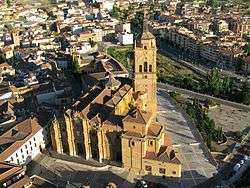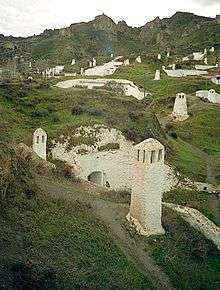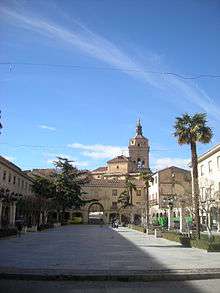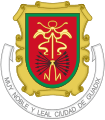Guadix
| Guadix | ||
|---|---|---|
| Municipality | ||
 Guadix Cathedral | ||
| ||
 Guadix Location in Spain | ||
| Coordinates: 37°18′N 3°8′W / 37.300°N 3.133°WCoordinates: 37°18′N 3°8′W / 37.300°N 3.133°W | ||
| Country |
| |
| Autonomous community |
| |
| Province | Granada | |
| Comarca | Comarca de Guadix | |
| Judicial district | Guadix | |
| Government | ||
| • Mayor | Inmaculada Olea (PSOE) | |
| Area | ||
| • Total | 317 km2 (122 sq mi) | |
| Elevation | 949 m (3,114 ft) | |
| Population (2016) | ||
| • Total | 18,796 | |
| • Density | 59/km2 (150/sq mi) | |
| Demonym(s) | Accitanos, Guadijeños | |
| Time zone | UTC+1 (CET) | |
| • Summer (DST) | UTC+2 (CEST) | |
| Postal code | 18500 | |
| Website | Official website | |
Guadix (Spanish pronunciation: [ɡwaˈðiks]) is a city in southern Spain, in the province of Granada, on the left bank of the river Guadix, a sub-tributary of the Guadiana Menor, and on the Madrid-Valdepeñas-Almería railway. It occupies part of an elevated plateau among the northern foothills of the Sierra Nevada.
The city was once famous for its cutlery; but its modern manufactures (chiefly earthenware, hempen goods, and hats) are relatively unimportant. It has some trade in wool, cotton, flax, corn and liqueurs. The warm mineral springs of Cortes y Graena, much frequented during the summer, are 6 miles west.
History
Ancient
Guadix el Viejo, 6 km northwest, was the Roman Acci (also Accitum) mentioned in Pliny's Natural History and as Akki by Ptolemy, who placed it among the Bastetani, whose capital was Basti. It is not known for certain whether it is of Phoenician or of early Spanish origin. According to Macrobius, the primitive inhabitants paid homage to Mars under the name of Neton. Julius Caesar established the Roman colony called Julia Gemella. According to tradition, it was the seat of the first bishopric in Hispania, in the 2nd century.
Moors to Reconquista
After 711 it rose to some importance as a Moorish fortress and trading station, renamed Wadi 'Ashi ("the Wadi of Acci").[1] During this period, Guadix was home to Ḥamda bint Ziyād, one of medieval Andalucia's foremost women poets. Guadix was the site of the Battle of Guadix in January 1362 in which a small Castilian army was routed by the forces of Muhammed VI, Sultan of Granada.[2] It was surrendered without a siege to the Spaniards, under Ferdinand and Isabella, in 1489.
Modern
The novelist Pedro Antonio de Alarcon, author of El Sombrero de Tres Picos (The Three-cornered Hat) was born in Guadix in 1833. The 19th and 20th centuries saw a period of economical crisis for the town. Currently Guadix is a center of production of fruit (strawberries), cereals, vegetables, as well as a minor tourist center.
Main sights


- Guadix Cathedral (16th-18th centuries), built over a Moorish mosque in Gothic-Renaissance style. The façade is in Baroque style.
- Church of St. Augustine (18th century),
- Church of Santiago (1540), with a Plateresque portal
- Convent and church of the Conception
- Alcazaba, a Moorish fortress commanding the town
- Barrio de Santiago, a neighborhood characterized by troglodyte houses carved in tuff rocks.

International relations
Twin towns — Sister cities
Guadix is twinned with:
See also
References
- ↑ Princeton Encyclopedia
- ↑ Mérimée, Prosper (1848). "Histoire de Dan Pédre". Revue des deux mondes (in French). Au bureau de la Revue des deux mondes. pp. 280–281. Retrieved 2013-07-15.

- Richard Stillwell, ed. Princeton Encyclopedia of Classical Sites, 1976: "Acci (Guadix), Granada, Spain"
External links
| Wikimedia Commons has media related to Guadix. |
